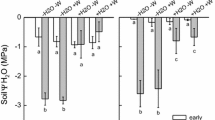Abstract
Two years after planting, five populations of yellow-cedar (Chamaecyparis nootkatensis (D.Don) Spach) stecklings (rooted cuttings) at two latitudes and two elevations were tested for freezing tolerance through the winter by the freeze-induced electrolyte leakage method. There were few significant differences in freezing damage among the five populations. Freezing tolerance closely followed trends in daily mean temperature. At the southern latitude sites, high elevation stecklings were less damaged by freezing than low elevation stecklings in the autumn and late spring. No consistent elevational differences in freezing tolerance of stecklings were observed at the northern latitude sites.
Similar content being viewed by others
References
Cherry, M. 1992. Genetic variation in frost hardiness of western red cedar (Thuja plicataDonn) seedlings. Northwest Sci. 66: 116.
Cherry, M.L. and Lester, D.T. 1992. Genetic variation in Chamaecyparis nootkatensis from coastal British Columbia. West. J. Appl. For. 7: 25–29.
Colombo, S.J., Glerum, C. and Webb, D.P. 1984. Frost hardiness testing: An operational manual for use with extended greenhouse culture. Ontario Ministry of Natural Resources. Forest Research Report No. 110. 14 pp.
Copes, D.L. 1981. Isoenzyme uniformity in western red cedar seedlings from Oregon and Washington. Can. J. For. Res. 11: 451–453.
Council of Forest Industries. 1989. British Columbia Forest Industry Statistical Tables, April. COFI of B.C. 1200, 555 Burrard St. Vancouver, B.C. V7X 1S7.
Griffin, R.A. and Ching, K.K. 1977. Geographic variation in Douglas-fir from the coastal ranges of California. I. Seed, seedling growth and hardiness characteristics. Silvae Genet. 26: 149–157.
Hawkins, B.J. and McDonald, S.E. 1993. Photoperiod influences dehardening of Chamaecyparis nootkatensis seedlings. Can. J. For. Res. 23: 2452–2454.
Hawkins, B.J., Russell, J.and Shortt, R. 1994.Effect of population, environment and maturation on the frost hardiness of yellow-cedar (Chamaecyparis nootkatensis). Can. J. For. Res. 24: 945–953.
Hunt, R.S. and Von Rudloff, E. 1977. Leaf-oil-terpene variation in western white pine populations of the Pacific Northwest. For. Sci. 23: 507–516.
Kuser, J.E. and Ching, K.K. 1980. Provenance variation in phenology and cold hardiness of western hemlock seedlings. For. Sci. 26: 463–470.
Rehfeldt, G.E. 1982. Differentiation of Larix occidentalispopulations from the Northern Rocky Mountains. Silvae Genet. 31: 13–19.
Rehfeldt, G.E. 1983. Ecological adaptations in Douglas-fir (Pseudotsuga menziesii var. glauca) populations. III Central Idaho. Can. J. For. Res. 13: 622–632.
Rehfeldt, G.E. 1986. Adaptive variation in Pinus ponderosa from intermountain regions. I. Snake and Salmon River Basins. For. Sci. 32: 79–92.
Rehfeldt, G.E. 1994. Genetic structure of western red cedar populations in the Interior West. Can. J. For. Res. 24: 670–680.
Russell, J.H. 1992. Clonal forestry with yellow-cedar, pp. 188–201. In:Ahuja, M.R. and Libby, W.R. (Eds) Clonal Forestry II. Springer-Verlag, Berlin.
Russell, J.H. 1993. Genetic architecture, genecology and phenotypic plasticity in seed and seedling traits of yellow-cedar (Chamaecyparis nootkatensis(D.Don) Spach) Ph.D. thesis. University of British Columbia, Vancouver. 168 pp.
SAS Institute Inc. 1988. SAS Procedures Guide, Release 6.03 Edition Cary, NC: SAS Institute Inc. 441 pp.
Silim, S.N. and Lavender, D.P. 1994. Seasonal patterns and environmental regulation of frost hardiness in shoots of seedlings of Thuja plicata, Chamaecyparis nootkatensis, and Picea glauca. Can. J. Bot. 72: 309–316.
Thomas, B.R. and Lester, D.T. 1992. An examination of regional, provenance, and family variation in cold hardiness of Pinus monticola. Can. J. For. Res. 22: 1917–1921.
Von Rudloff, E. and Lapp, M.S. 1979. Population variation in the leaf of terpene composition of western red cedar, Thuja plicata. Can. J. Bot. 57: 476–479.
Yeh, F.C. 1988. Isozyme variation of Thuja plicata(Cupressaceae) in British Columbia. Biochemical Systematics and Ecology 16: 373–377.
Ying, C.C. 1990. Adaptive variation in Douglas-fir, Sitka spruce, and true fir: A summary of provenance research in coastal British Columbia, pp. 2.378–2.379. In: Proceedings of the Joint Meeting of the Western Forest Genetics Association and IUFRO Working Parties S2.02, 05, 06, 12 and 14. Aug. 20–24, 1990. Olympia, WA.
Author information
Authors and Affiliations
Corresponding author
Rights and permissions
About this article
Cite this article
Davradou, M., Hawkins, B. Effects of plantation location and population on the seasonal freezing tolerance of yellow-cedar (Chamaecyparis nootkatensis) stecklings. New Forests 15, 77–87 (1998). https://doi.org/10.1023/A:1006516525101
Issue Date:
DOI: https://doi.org/10.1023/A:1006516525101




